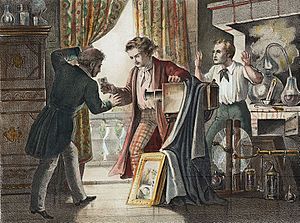Claude Niépce facts for kids
Claude Félix Abel Niépce (born 1764, died 1828) was a French inventor. He was the older brother of Nicéphore Niépce, who became famous for inventing photography. Claude went to England to find support for an engine they had invented. He passed away there. Many people remember his brother more because of photography.
Life of an Inventor
Claude Félix Abel Niépce was born on October 28, 1764. His family lived in Chalon-sur-Saône, France. They were landowners and had connections to the royal family. His younger brother, Nicéphore, was a soldier. After leaving the army, Nicéphore settled in Nice. Claude joined him there. Together, they started thinking about how to build a new type of engine. This was an internal-combustion engine.
In 1801, the brothers returned to their family home. It was called Le Gras, near Chalon. There, they worked on many inventions. One big project was the Pyréolophore. This was the world's first internal combustion boat engine. It used a mix of coal dust and a special powder called lycopodium. They successfully tested it on the nearby River Saône.
In 1807, the French government held a contest. They wanted a new way to pump water to the Palace of Versailles. The Niépce brothers designed a simple system. It used just a few parts to pump water up a long distance. However, their design was not chosen. Another inventor's steam engine was picked instead.
The Pyréolophore Patent
Emperor Napoleon Bonaparte gave Claude and Nicéphore a patent for their engine in 1807. A patent is like a special permission. It means only they could make and sell their invention for a certain time. They kept working on the engine. They tried using liquid fuel instead of powder. They even developed an early fuel injection system. This system sprays fuel into the engine.
Life in France after the revolution was hard. By 1817, the brothers could not find anyone to invest money in their engine. So, their ten-year patent ran out. Claude was worried about losing control of their invention. He traveled to Paris and then to England. He hoped to find support for the Pyréolophore there. On December 23, 1817, he received a patent from King George III of England.
Challenges and Legacy
Getting a patent in England did not solve their problems. Claude stayed in London for ten years. He lived in a place called Kew. During this time, he became very ill. He spent a lot of the family's money on bad business ideas for the Pyréolophore.
Meanwhile, his brother Nicéphore was working on something new. From 1816, Nicéphore experimented with light-sensitive materials. He used a substance called bitumen of Judea. This was the same material they had used as fuel for the Pyréolophore. Nicéphore used it to create images. Around 1824, he made the first permanent photographs. He even brought some samples to London to show Claude.
Claude became very sick. He passed away in early 1828. After Claude's death, Nicéphore returned to France. Their cousin, Abel Niépce de Saint-Victor, also became a famous inventor in photography.



